Spring in your steps: four great UK walks that banish winter

England: west Dorset
If you drive along the A3066 towards Bridport in springtime, you might get a tantalising glimpse of pink apple blossom in the centre of Melplash village. If you park in the layby opposite the Half Moon pub, you will find there is a footpath that leads through the trees and on, up and over Hincknowle Hill.
This little orchard was planted in 2011 by the late Rupert Best. It is a very Dorset orchard, full of unique lost-and-found-again cider apple trees. It is special to me, since it represents 10 years of searching for old apple trees in forgotten corners of Dorset with my friend Nick, from West Milton Cider near Bridport.
The orchard greets me with the perfume of trees in bloom and the buzz of flying insects
I go there often with my two collies. In mid-May, when the sun is shining, the orchard greets me with the perfume of 50 or more trees in full bloom, their pink and white blossom buzzing with all manner of flying insects. My dogs will be off searching for rabbits under the low branches. They might startle a fox or spook a green woodpecker.
As I walk through the trees, I like to remember how we discovered each of them on our quests around Dorset. Every tree is an individual character with its own story.
We found some in abandoned farm orchards, their apples rotting on the ground. Others we rescued, sheep nibbled but just surviving, from the corners of fields. One orphan tree, Fillbarrel, a remnant from an ancient orchard, was growing in the garden of a newly built bungalow. We found a tree with the prettiest dark red blossom in a churchyard.
A pair of trees, one we called Rough’n’Reddy, and the other Mutton Street Marvel, unearthed some local history for us. They were discovered growing deep in the lanes of Marshwood Vale near the old flax and hemp ropeworkers’ cottages. Perhaps 100 years ago these little crab apples would have made them some very sharp, tannic cider.
Nick and I found several old trees in the village of Loders, near Bridport, close to the priory where it’s said monks from northern France grew apples and made cider, even before the conquest. Ours may only be recent relatives, but Dorset can indeed boast that it was the first place in England where cider was made.
The county once had more than 10,000 acres of orchards. Sadly, so many West Country farm orchards have disappeared – over two-thirds have been lost since the 1960s, some replaced with bush trees for big commercial cider-makers.
Nick and I feel we have helped redress the county’s balance by offering Dorset’s growing band of young craft cider-makers apples with a traditional local flavour. Walking between these trees in full bloom, taking in their perfume, seeing them healthy, laden with blossom and full of promise that there will be plenty of fruit this autumn to make some rather good cider, what could be more rewarding?
But I shall have to wait till next year before I can taste it.
Nick Poole’s West Milton cider is on tap at the Pursuit of Hoppiness, Bridport and Spyway Inn, Askerswell.
The Lost Orchards by Liz Copas with Nick Poole is published by Little Toller, price £18
Liz Copas
Wales: Montgomery, Powys
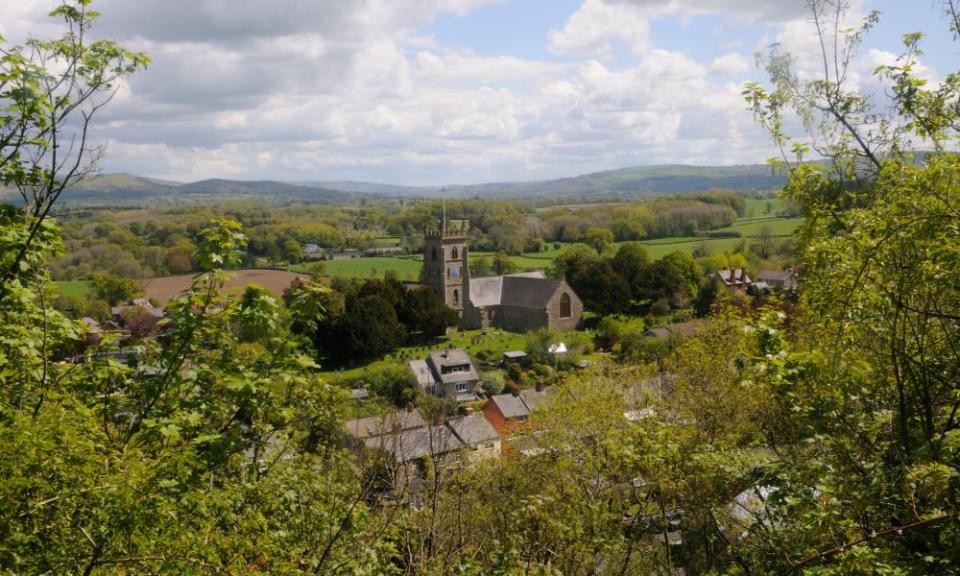
You might be forgiven for thinking you have wandered on to a film set, probably for something wholesome involving midwives on bicycles. The Georgian and Victorian buildings ooze with character; there are retro signs; a ruined castle on a rock; and, in spring, primroses and daffodils on the banks.
Montgomery town is pretty. Look closer, however, and it does have a touch of darkness about it. There’s the former prison on the hill and an erstwhile “house of correction”. The information plates on the stone walls tell of lawyers, bailiffs and court sessions. In the right director’s hands, I reckon, those wholesome midwives could become zombie flesh-eaters.
Head up to one of best 360-degree views in Wales – to Cadair Idris in the west, and the Peak District in the north-east
Sleepy rural idyll it may be, but once this was a tough border town, brought to importance by a ford on the nearby River Severn. Park in Broad Street, the old marketplace, and head north through the town past the best ironmongers you will ever find, Bunners, and the small but excellent Old Bell museum. Keep left along the B4385. The great lump of rock on your left so impressed a youthful King Henry III that he ordered a castle built there in 1223. Forty-four years later, Henry was back, this time to sign a treaty with the Prince of Wales, Llywelyn ap Gruffudd.
After you have left the town, where the road bends right, cross over and take the footpath up into the woods. Eventually this will bring you up on a knoll, Ffridd Faldwyn, once an iron age hill fort. Continue over the top and down until you reach the minor road. Here there’s a choice: carry on across and follow the contours south-west until reaching another minor road, where you turn back north-east and make your way up to the war memorial on Town Hill.
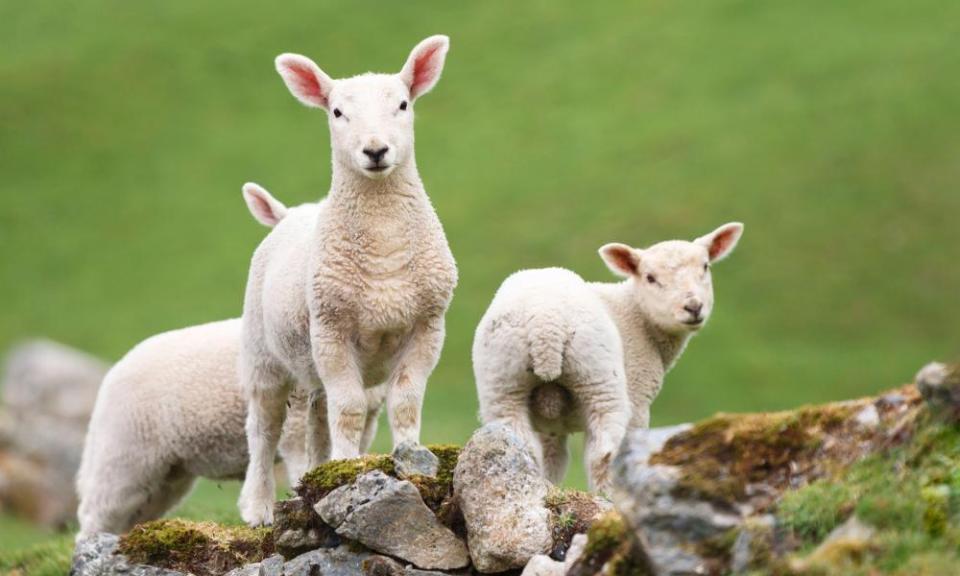
Alternatively, turn left up the minor road until you see the entrance to the castle – definitely worth a visit when it’s open. From here, head uphill to the war memorial, where you get one of the best 360-degree views in Wales – 34 miles to Cadair Idris in the west and more than 60 miles to the Derbyshire Peaks in the north-east. Sit down here and have your picnic while identifying distant summits and watching the spring lambs in the fields below.
Retrace your steps to the road, then take the lane down past the old gaol and the Dragon hotel into Broad Street. There are cafes and a bookshop. On the far side, in the churchyard, is a salutary lesson for all lawyers, courts and prisons: the burial place of John Davies. In 1821 he was framed by a love rival, convicted of highway robbery, and condemned to death. As he was taken to the gallows, the town was reportedly engulfed in thunder and lightning and Davies uttered a dreadful curse: that no grass would grow on his grave (I do think he might have been a tad more severe on his false accusers). Sure enough, the grass did not prosper for a century and even now it is quite patchy.
Kevin Rushby
Scotland: Sutherland
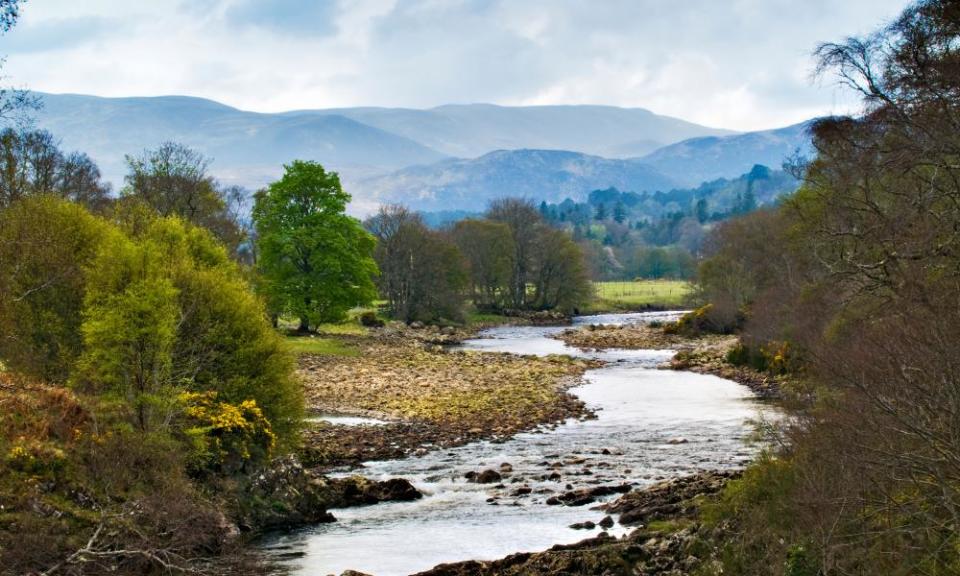
The River Carron falls through a ghostly Highland glen where the history runs as dark and turbulent as the water. I like to fish for spring salmon in its swirling pools, the weather cleansing my soul of winter.
You know life is returning when the gorse on the riverbank starts to pop and scrawny lambs toddle and form gangs
If I arrive too early, before hope has tinted the trees, snow squalls will barrel down the glen, bare birch on the scoured hills appearing for a moment before being eclipsed. But as the days pass, the sun warms the clear northern air.
As elsewhere, spring emerges as snowdrops, but in Sutherland you really know life is returning when the gorse on the riverbank starts to pop, buds emerging. Scrawny cheviot lambs stagger, toddle and form gangs. Mercifully, it’s too soon for midges.
There’s a good out-and-back walk where a beautiful old road bridge crosses. Walk up the left bank into Gledfield estate, listening for a cuckoo newly returned from Africa to ruin a meadow pipit’s family life.
Not far from the bridge, one spring in 1650, the Marquis of Montrose lost the battle of Carbisdale during the wars of the three kingdoms. The poet-soldier was hanged, beheaded and quartered a month later, but Walter Scott would turn him into a romantic hero any mother – or at least mine – could love.
Upstream, the glen crowds in around Braelangwell, where I most like to fly-fish. We are chasing after Atlantic salmon, the finest of all fish. They have spent several years at sea – in the chilly waters off Greenland or Svalbard – and are running back to the river of their youth.
The river chases through a gorge and drops into the Morail, a large pool. Salmon stack up, waiting for the water to warm enough for them to run the falls. If there has been rain overnight, I can hear the thunder of the water from the house above, and my heart pounds with hope.
My childhood friend Finlay is the ghillie (or riverkeeper) and he says the sound of the first oystercatcher often suggests the season’s first salmon. If the fishing is slow and the sun warm, we’ll sit on the bank and chat as his cocker spaniels investigate the bushes nearby. Fishing is sedate enough that nature can reassert itself around you.
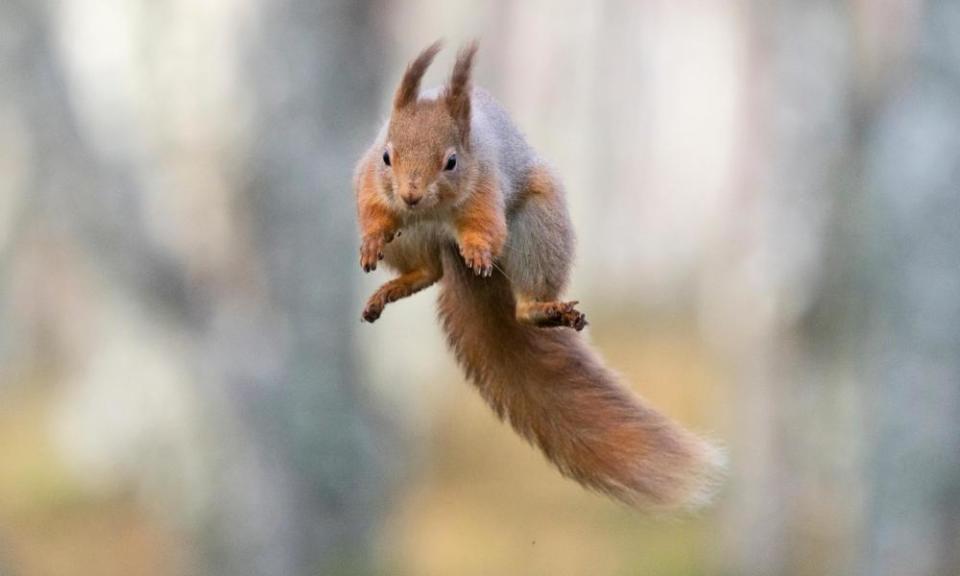
A famous sin occurred farther upstream. In May 1845, the glen’s crofters were evicted – “cleared” – from their homes by a rapacious laird. Huddling in a graveyard, these poor Calvinists blamed themselves for their misfortune, etching misery into the glass of the kirk windows: “Glencalvie people. The wicked generation.”
Farther up yet, Paul Lister of Alladale wilderness reserve has spent 20 years planting a million Scots pine, rowan, holly and birch to regenerate the ancient forest. He wants to bring back wolves.
For the moment, my eyes can stay on the river. There was an afternoon when the days were still short when a storm covered the ground with snow. In a pool called the Washerwoman a salmon took, jumping upstream in long, smooth arcs. It seemed almost translucent in the stormy air.
That night I told my friends it appeared like a phantom, “a ghost fish leaping through the falling snowflakes”. They still mock me about it, mimicking me. I don’t care; I remain haunted.
Ruaridh Nicoll
Northern Ireland: Derry coast
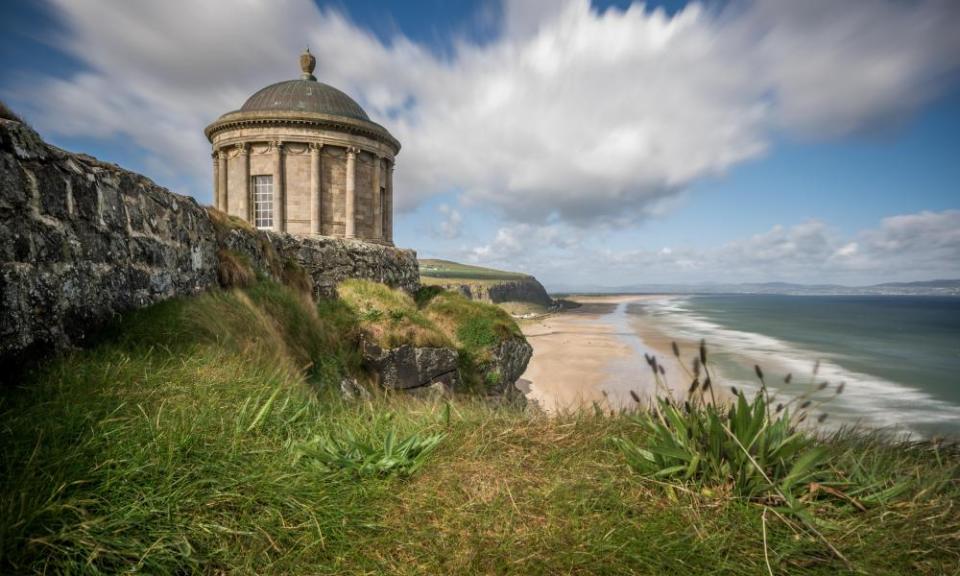
From Castlerock station, north-west of Coleraine in County Derry, walk to Tunnel Brae. You’ll come to the Gate Lodge entrance to Downhill Demesne, the former estate of Earl-Bishop Frederick Hervey (1730–1803), and now a National Trust property. Motorists can park in the Black Glen car park but will need transport at the walk’s other end. However, you could ramble through this Area of Outstanding Natural Beauty by a circular or about-turn route. There are plenty of stopping places along the adjacent A2 road, which also carries a bus service linking Limavady and Coleraine.
Your gaze will swing between the breakers’ exuberance and the Antrim plateau’s scarps
Take the grassy cliffside path. To the east are extensive beaches bracketed by headlands that recede beyond Portrush. Look for the blurs of Islay and Jura on the horizon. Then stare across the sea to the Inishowen peninsula. As you walk on, your gaze will plunge into Port Vantage, the mouth of the Black Glen. Here, the railway skims the Atlantic’s wash between the Castlerock and Downhill tunnels. None of the old cliches about breathtaking and heartstopping can do justice to this view. Across the ravine, the next headland is capped by the clifftop folly of Mussenden Temple. Hold your surprise at its neoclassical beauty. Let your gaze drift further along to where the tide’s lace flutters against the long bow of strand that stretches to the high dunes of Magilligan Point. That’s where you’re headed.
You’ll have to veer around the Black Glen to get there. In the wooded heart of the demesne, within shouting distance of Bishop’s Gate, you’ll still hear the funnelled roar of the sea.
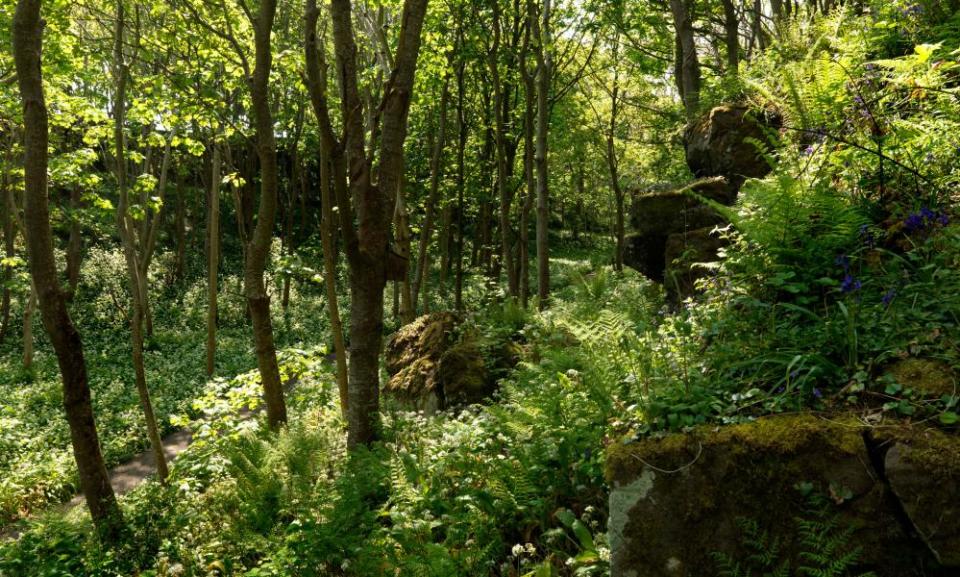
Emerging onto grassland, you will see a gargantuan ruin on the brow of the hill. This was the Earl-Bishop’s residence. Signage announces that Mussenden Temple was built to honour a young female cousin of whom the Earl-Bishop was “very fond”. Hmm. Folly indeed.
Yet the temple’s exquisite formality seems to speak to its rugged surroundings. Contained passion is in every line and curve of stone. Puzzle over the Latin inscriptions under the eaves. Peek through the keyhole of the Georgian doors. Then lean over the wall to stare down at the fulmars winging the updrafts.
Exit the demesne by Lion’s Gate (National Trust charges apply to the car park). The short descent to the beach at Downhill village is by the A2, but there’s a footpath for most of the way. The beach entrance is bridged by the railway.
Downhill’s strand segues into Benone’s, and then Magilligan’s (the latter is off-limits as a military firing range, but four miles of glazed sand is quite sufficient). Your gaze will swing between the breakers’ exuberance and the Antrim plateau’s westernmost scarps. As the hinterland morphs into a swathe of dunes, passing trains will turn away towards Binevenagh mountain. You’ve reached Benone. Exit at Benone beach tourist complex with its car park. The bus stop is at the entrance, a short walk from the Anglers Rest.
Mary Montague


